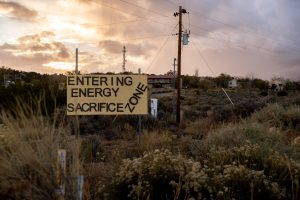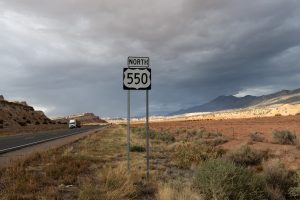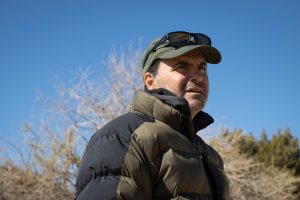Eds: A previous version of this story misstated the year when the changes to New Mexico oil and gas regulations were approved. The legislature approved the changes in 2019, with a 2020 effective date. The error was in the 30th graf. The story below has been corrected, but clients who ran earlier versions are asked to run the clarification found here.
- Slug: Gaslit-New Mexico, 2,760 words.
- 9 photos available (thumbnails, captions below)
- Mandatory credit noted at the end of text.
By Isabel Koyama, Sarah Suwalsky, Jimmy Cloutier and Zach Van Arsdale
Howard Center for Investigative Journalism
COUNSELOR, New Mexico — Bright pink flags mark a swath of newly cleared land, rubber water hoses snake along the roadside and pump jacks dot the horizon, all signs of the state’s growth as an oil and gas hub.
But even as production expands across New Mexico, the state is trying to shrink its global warming footprint through stringent new rules that require oil and gas companies to cut the amount of methane-rich natural gas they push into the atmosphere and more accurately track their emissions.
New Mexico ranked second in crude oil production, behind Texas, as of September 2021, and is among the nation’s top producers of natural gas, according to the U.S. Energy Information Administration. Those oil and gas operations pump more than $2 billion into New Mexico’s budget every year.
That leaves Democratic Gov. Michelle Lujan Grisham — who campaigned on clean energy and is running for reelection in 2022 — walking a fine line between climate-conscious regulations and preserving an industry crucial to her state’s economy.
Shortly after taking office in 2019, the governor ordered the Environmental and Energy, Minerals and Natural Resources departments to oversee the development of tough, new regulations aimed at reducing methane emissions from the oil and gas industry. Methane has more than 80 times the global warming power of carbon dioxide in the short term, which is why scientists say cutting methane emissions is the quickest way to slow the rate of global warming.
In the first three years of Lujan Grisham’s administration, however, the state issued 6,970 oil and gas drilling permits — more per year, on average, than her Republican predecessor. Of the nearly 51,000 active oil and gas wells, nearly 2,800 were completed under Lujan Grisham.
“You’ve got the governor wanting it both ways,” said Tom Singer, senior policy adviser for the Western Environmental Law Center. “She likes the money. She loves the oil and gas industry.”
The governor’s office did not respond to three requests for an interview.
The tension between growth and regulation is evident across New Mexico, from the northwest San Juan Basin, one of the richest natural gas reserves in the United States, to the Permian Basin, which straddles the state’s southeastern border with Texas and is the most prolific oil and gas region in the country.
Perhaps nowhere is that more evident, though, than along Route 550. The highway bisects the San Juan Basin from southwestern Colorado, along the eastern edge of the Navajo Nation, past small towns such as Counselor with both historic and emerging ties to the oil and gas industry.
A sign outside Counselor welcomes visitors to what environmental activists have called an “Energy Sacrifice Zone.” Oil and gas wells — spaced along a network of unpaved roads branching off the highway — penetrate the landscape, disrupting desert vistas of juniper brush framed by mesas and canyons.
San Juan, Rio Arriba and Sandoval counties in northwest New Mexico are home to more than 21,000 active wells, and oil and gas development has been creeping south toward Counselor and Cuba, encroaching on the Greater Chaco region, a land rich in Indigenous history and culture.
Mario Atencio sees the wells every time he drives his high-clearance pickup along the rugged back roads intersecting Route 550. On a tour of the area in October 2021, he stopped at a patch of newly cleared land marked by pink flags. Federal government records show that plans for the site include at least two oil and natural gas horizontal drilling wells, a well pad, an access road and a pipeline corridor.
“This is what it looks like: front lines of the great environmental climate change battle,” Atencio said. “It’s very silent; it’s very lonely.”
Atencio, a legislative district assistant to the Navajo Nation Council, knows the area by heart, having spent childhood summers with family in Counselor. After witnessing the impact of oil and gas operations, he became one of the state’s leading environmental justice organizers, helping the Greater Chaco Coalition expand into a large network of tribal organizations, nonprofits and other supporters.
The coalition was instrumental in convincing the White House to temporarily pause new federal oil and gas leasing within a 10-mile buffer zone of the Chaco Culture National Historical Park, a UNESCO World Heritage Site. However, oil and gas companies can continue to develop existing leases near Chaco, and the federal government is moving forward with lease sales outside the buffer zone.
Atencio is skeptical of the governor’s push for greater regulation of the oil and gas industry, which includes a goal of preventing 98% of natural gas from escaping operations by 2026.
“We have yet to hear any type of real investment in enforcement,” Atencio said of the new methane rules. Until that happens, he added, “it’s just words on paper.”
An incomplete picture
The state’s new natural gas waste reduction rules took effect in May 2021. But some environmentalists and community activists contend they allow for too many exemptions that will allow oil and gas operators to continue releasing harmful gases into the atmosphere.
Although operators sometimes need to release natural gas during emergencies or regular maintenance, the industry also gets rid of gas deemed too costly to capture, according to a U.S. Energy Department report.
Odorless and hard to detect, methane also leaks from pipelines and wellheads. It’s pushed into the atmosphere through flaring or venting, industry practices that combust or simply release natural gas. Almost two-thirds of methane emissions in New Mexico come from the oil and gas industry, according to a 2019 state climate report.
State and federal regulators rely on data that companies report — and require the data to be accurate — for audits by the Oil Conservation Division, part of the state energy department that’s responsible for regulating oil and gas.
Scientists and policymakers say it’s impossible to target greenhouse gas reductions if no one knows the full extent of their volumes. So, in recent years, scientists have turned to satellite data to measure flaring volumes in the oil and gas industry.
The Howard Center for Investigative Journalism, using the same kind of satellite data, analyzed New Mexico flaring volumes and compared them to state records. The analysis showed that satellites recorded about 50% more flaring from 2014 to 2020 than was reported to the state.
Susan Torres, a spokesperson for the state’s Energy, Minerals and Natural Resources Department, said its Oil Conservation Division “can’t validate how the satellite calculates and evaluates data.” However, she noted, “OCD knows how important data collection and reporting is and made that a primary component of our new waste rules.”
New Mexico has long been known as a methane hot spot.
In 2014, satellites identified a methane plume the size of Delaware hovering over the San Juan Basin. Scientists found that despite other sources of emissions in the area, the fossil fuel industry was the primary culprit. About three-quarters of all methane emissions in the basin derived from oil, gas and coalbed operations, according to a research study funded by the federal government. Topography and weather patterns of the basin could exacerbate methane concentrations, the study said.
In addition, a 2019 state climate report said that methane emissions accounted for almost a third of New Mexico’s greenhouse gas emissions, compared to 10% nationally.
The state’s new rules ban any routine, or nonemergency, flaring or venting of natural gas, and tighten reporting and gas-capture requirements. Starting in April 2022, oil and gas operators will need to reduce the volume of gas flared or vented annually in order to meet the 98% gas capture goal by 2026.
The rules also expand the state’s enforcement power. In 2019, the state legislature reinstated the Oil Conservation Division’s authority to issue fines of up to $200,000 per violation of New Mexico’s Oil and Gas Act. The law, which took effect in 2020, restored power that had been denied to regulators for a decade. In addition, the Division can now deny drilling permits to operators who cannot demonstrate how they will meet the state’s gas-capture goal. And, for the first time, operators must report on flaring and venting at midstream, or processing, operations and not just at the well site. Regulators say that will provide a fuller picture of oil and gas emissions and introduce a large data set that was previously nonexistent.
To prepare for that better data collection, the division has updated its internal computing system, the director of the state’s Oil Conservation Division, Adrienne Sandoval, told the Howard Center.
However, environmental activists who helped draft the new regulations question whether the rules go far enough or if the Oil Conservation Division has the necessary resources to enforce them.
Operators may still flare — or vent if flaring isn’t technically feasible — when a well is being primed for production, or “completed,” meaning that with each newly drilled well greenhouse gases may be released into the atmosphere. The completion process can take up to several weeks.
Don Schreiber, a rancher and activist in northwest New Mexico, has 122 gas wells around his land that he says regularly release gas. Schreiber lives on what is called a split-estate, meaning he owns the surface rights, but not the rights to the minerals below ground.
Though methane emissions are invisible to the naked eye, Schreiber says he’s seen them through an infrared camera more than a dozen times and has come to recognize other smells, such as the paint-thinner stench of xylene, leaking from the wells on his property.
“I don’t know exactly what routine venting and flaring is, but the routine here is they vent all the time,” Schreiber said.
Mike Eisenfeld, energy and climate program manager of the San Juan Citizens Alliance, a nonprofit environmental organization, said the state’s environmental and natural resources departments are “woefully underfunded.”
According to its staff directory, and confirmed by the division, the state employs 11 inspectors, who are responsible for checking about 51,000 active wells.
Neighboring Colorado, which has some of the nation’s strictest rules governing the oil and gas industry, has more than twice as many inspectors for almost as many wells. Colorado’s regulatory body, the Oil and Gas Conservation Commission, also received 50% more in funding for the 2021 fiscal year than its New Mexico counterpart.
“I think the waste rule is pretty thorough, pretty comprehensive,” said Singer, who served on an advisory panel for the new regulations. “The trick is getting it enforced.”
At a New Mexico Climate Summit, held at the state Capitol in Santa Fe in October 2021, the head of the Energy, Minerals and Natural Resources Department made multiple pitches for a bigger budget going into the next legislative session.
Sarah Propst, the department’s cabinet secretary, is requesting a $3.1 million increase to the Oil Conservation Division’s budget, part of which would add 25 more full-time staff, including eight more inspectors.
The governor’s ultimate goal is to reach net-zero emissions by 2050, the same goal President Joe Biden set for the federal government in a 2021 executive order.
“For a small state with some pretty interesting challenges, we are in fact leading the country in any number of environmental strategies, policies and statutory frameworks at reducing our emissions and increasing our reliance on renewable energy,” Lujan Grisham told the climate summit.
A ‘jurisdictional morass’
The task of overseeing compliance from New Mexico’s oil and gas industry is further complicated by the fact that nearly a third of public land is federally owned. The Bureau of Land Management oversees nearly 4.3 million acres of federal oil and gas leases, second only to Wyoming.
In 2021, royalties from those operations brought in more than $2.3 billion, according to the federal Office of Natural Resources Revenue. That put New Mexico among the largest sources of oil and gas revenue for the federal government, second only to the Gulf of Mexico, according to data from the revenue office.
The office, part of the Interior Department, collects royalties from mineral extraction on federal and tribal lands and then distributes that money back to government agencies, funds, tribes and state governments. In 2021, New Mexico was the largest state recipient, receiving more than $1.1 billion, roughly half the disbursements to all state governments.
Aside from the state Oil Conservation Division and the federal BLM, the state Environmental Improvement Board, the federal Bureau of Indian Affairs and Environmental Protection Agency all play a role in the oil and gas industry in New Mexico.
Eisenfeld called that a “jurisdictional morass.”
In Counselor, where state, federal and tribal lands are quilted together like a checkerboard, Atencio said residents sometimes don’t know who to call if there’s a problem.
“You’re dumping hundreds of tons of volatile organic compounds into the landscape, and we don’t know who is in charge of it,” he said.
Satellite data analyzed by the Howard Center revealed that oil and gas operators on federal lands in New Mexico flared more than 138 billion cubic feet of gas, nearly half of the gas burned off in the state between 2012 and 2020. A BLM spokesperson said those volumes were “relatively accurate” based on data collected by federal regulators.
The Oil Conservation Division says it enforces state rules on federal lands too. But unlike Colorado, New Mexico has no formal written agreement — or Memorandum of Understanding — with the BLM that spells out interagency cooperation.
Colorado’s memorandum requires that the BLM invite state regulators to on-site inspections of federal oil and gas operations and that state and federal regulators consult one another on permitting and enforcement.
But without such a formal agreement in New Mexico, federal regulators have no authority to enforce state laws — including rules around natural gas flaring and venting, according to Richard Packer, the BLM spokesperson.
Instead, federal and state regulators communicate in formal quarterly meetings and impromptu calls on environmental matters, Packer said in an email.
BLM has 85 oil and gas inspectors in New Mexico, more than seven times the number of inspectors employed by the state. Thirty-eight of them work from a field office in Farmington, in the San Juan Basin.
Economic balancing act
For the last 26 years, Eisenfeld has been an outspoken environmental advocate in Farmington, a city with strong historic and economic ties to the oil and gas industry.
He lives just down the road from the Glade Run Recreation Area in north Farmington, where the BLM manages 19,000 acres of juniper brush, mountain bike paths and wells that lead into an arterial system of pump jacks and pipes.
“Because oil and gas is the main contributor to the state’s budget,” he said, “it’s always portrayed that, you know, that if you want your kids to have a good education, and if you want kind of your community to prosper, that you have to support oil and gas.”
New Mexico receives more than $2 billion in annual revenue from the oil and gas industry through severance taxes and royalties, according to the state legislative finance committee.
“People are just so consumed with this idea that … the only economic, economically viable thing for us is to sort of rely on fossil fuels,” said Eisenfeld, who thinks an economic transition to renewables is long overdue.
George Sharpe, an investment manager at an oil and gas company in Farmington, where he grew up, thinks the industry is more integral to the state’s economy than critics want to acknowledge.
“Forget the revenue directly to the state — the jobs … the activity that it supports,” he said. By contrast, he said, renewable energy sources — such as wind and solar power — would require a huge investment to scale up to becoming a reliable energy source for the state. “They just want to be able to snap their fingers and make it different,” Sharpe added. “And it just doesn’t work that way.”
Lujan Grisham acknowledged at the climate summit that the state’s oil and gas workforce is facing a big adjustment. “When you do this work, in fact, there are shifts in the employment structure,” the governor told a crowd of climate experts, tribal leaders and environmental advocates.
Propst asked for $30.1 million to advance partnerships with clean energy companies, train workers in the renewable energy sector and support New Mexico’s outdoor recreation economy.
The state’s ability to diversify its economy will be key to reducing its reliance on oil and gas, said Janie Chermak, chair of the economics department at the University of New Mexico, noting that neighboring states Texas and Colorado have done just that.
“New Mexico has that opportunity. But it’s difficult to do,” said Chermak. “It’s not feasible to just say oil and gas goes away.”
Reporter Maya Leachman contributed to this story. It was produced by the Howard Center for Investigative Journalism at Arizona State University’s Walter Cronkite School of Journalism and Mass Communication, an initiative of the Scripps Howard Foundation in honor of the late news industry executive and pioneer Roy W. Howard. For more see https://azpbs.org/gaslit. Contact us at howardcenter@asu.edu or on Twitter @HowardCenterASU.
^__=








